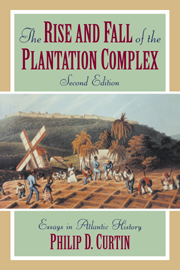Book contents
- Frontmatter
- Contents
- Preface
- Preface to first edition
- Beginnings
- 1 The Mediterranean origins
- 2 Sugar planting: from Cyprus to the Atlantic islands
- 3 Africa and the slave trade
- 4 Capitalism, feudalism, and sugar planting in Brazil
- 5 Bureaucrats and free lances in Spanish America
- Seventeenth-century transition
- Apogee and revolution
- Aftermath
- Appendix
- Index
4 - Capitalism, feudalism, and sugar planting in Brazil
Published online by Cambridge University Press: 05 June 2012
- Frontmatter
- Contents
- Preface
- Preface to first edition
- Beginnings
- 1 The Mediterranean origins
- 2 Sugar planting: from Cyprus to the Atlantic islands
- 3 Africa and the slave trade
- 4 Capitalism, feudalism, and sugar planting in Brazil
- 5 Bureaucrats and free lances in Spanish America
- Seventeenth-century transition
- Apogee and revolution
- Aftermath
- Appendix
- Index
Summary
Brazil was peculiarly important in the history of the plantation complex. In our ethnocentric way, many of us tend to think of the United States as the place where most slaves were landed. If fact, it was Brazil. Brazil was also the place where the characteristic elements of New World tropical slave plantations were first put together. Finally, in 1888 Brazil was the last country in the Western Hemisphere to abolish slavery.
Feudalism and capitalism
The early plantation complex in Brazil contained some institutional survivals from the medieval Mediterranean, as well as other institutions created for the new conditions of the New World. The Portuguese brought techniques for planting cane and making sugar from Madeira, but they also brought late feudalism and early capitalism from Europe. “Feudalism” has so many different means that precision is easily lost. In the strictest sense, “feudal” meanings “pertaining to a fief.” A fief in northwestern Europe, beginning in about the eleventh century, was a gift of valuable, income-producing property – usually control over land and peasants – in return for military service. It was therefore the basis of a special and close relationship between two members of the military aristocracy. He who gave the fief established his superiority, but both were honored members of a medieval elite.
- Type
- Chapter
- Information
- The Rise and Fall of the Plantation ComplexEssays in Atlantic History, pp. 46 - 57Publisher: Cambridge University PressPrint publication year: 1998

